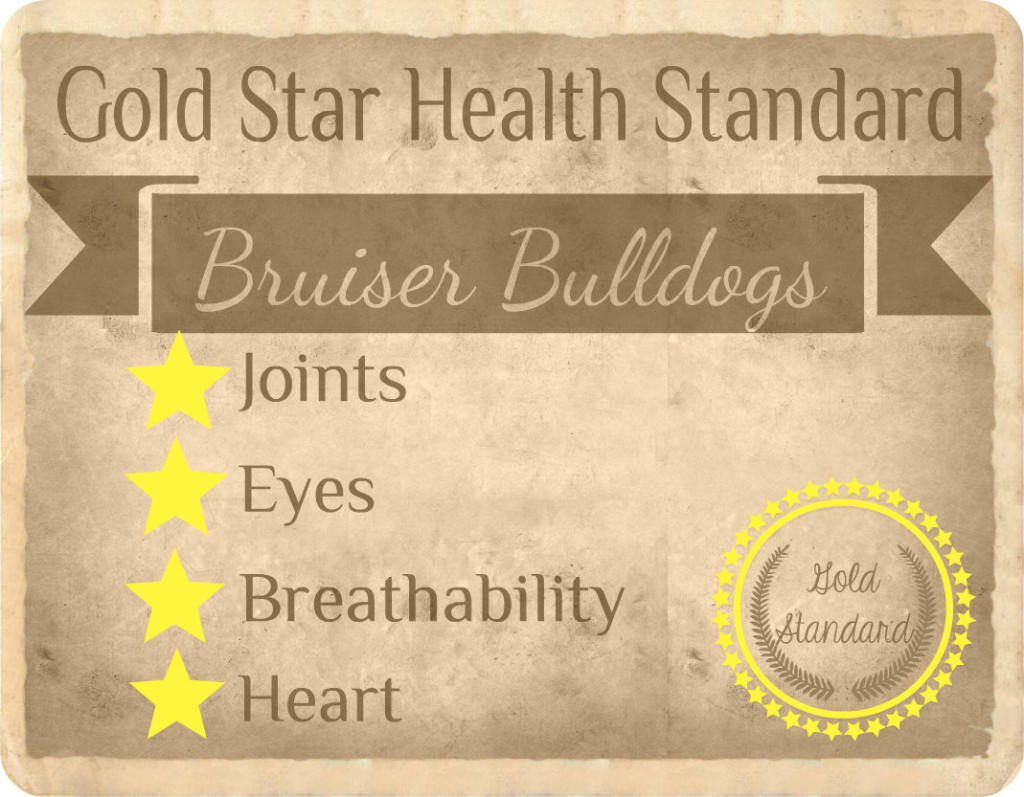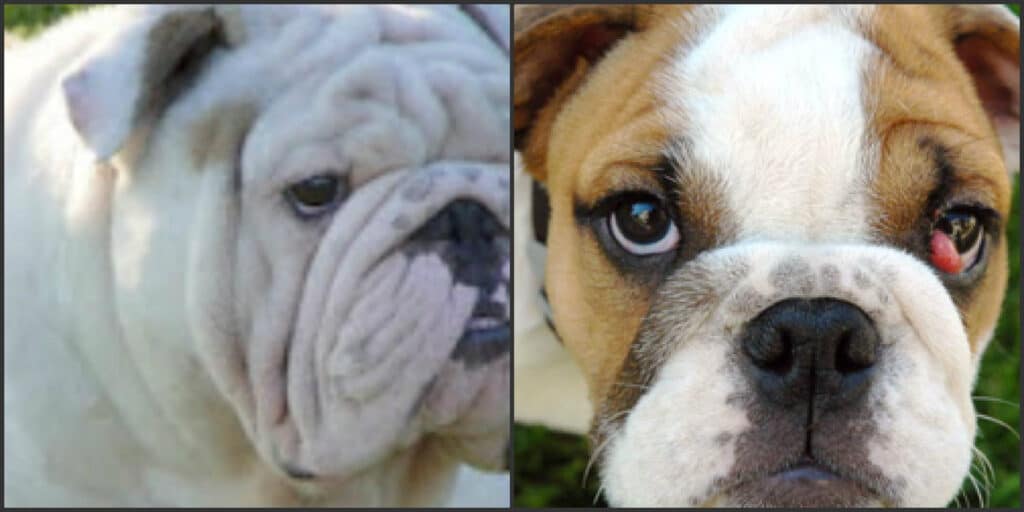Health
The keys to a successful breeding program are both extremely simple and complex all at the same time. From a very simple point of view, the goal is to create genetically healthy bulldogs by breeding generations of healthy bulldog ancestors. This continual process seeks to gradually improve each generation’s characteristics and eventually arrive at a very well-bred bloodline. While this goal seems simple enough, like many things, the process gets more complex upon taking a closer look. One of the biggest keys to creating a healthy bloodline is understanding the main health issues in the breed and ensuring that the bulldogs that are considered for breeding do not struggle with these issues. Below is our Gold Star Health Standard that all of our adult bulldogs must pass before being considered to enter into our breeding program.
“I have been highly impressed by Mitch and Erica Wysong’s selective breeding program and the
health of their Bruiserbulldogs. Through conscientious health testing and a focus on the hereditary
traits in their bloodlines. Mitch & Erica are bettering the breed by eliminating specific
health issues that affect the bulldog.”
- Rick Carmien D.V.M.
Our Gold Star Health Standard requires us to test each of our parent bulldogs to ensure they are healthy and free of the problems within each of these characteristics. While it seems obvious that the idea of breeding healthy parents would be one of the most important factors in creating healthy bulldog puppies . It is amazing how few bulldog breeders actually hold true to this belief system and health test their adult bulldogs. This detailed health criteria is what makes the bruiser bulldog unique from other bulldogs and really sets us apart.
“Bruiser Bulldogs take care in selecting and breeding only the healthiest bulldogs. Health checks are performed on each breeding animal’s trachea, soft palate, heart, knees and eyes. This helps them to ensure high quality and healthy puppies.”
-Hillary Reinhold D.V.M.
Below is a detailed break down of our Gold Star Health Standard that each of our bulldogs must pass before being eligible to breed to.
Overdone, Wrinkly Bulldogs and Elongated Soft Palates
 Many bulldogs famously suffer from breathing issues that hinder their ability to function on an every day basis. One of the primary reasons for heat stroke in the hot summer months is due to the inability of the bulldog to breath properly. A closer examination of the bulldogs suffering from breathing issues reveals that the over done, heavy roped bulldogs are much more susceptible to these issue. The extra wrinkly bulldog, typically will have a shorter snout that turns upward towards the forehead. This creates numerous issues the first being the elongated soft palate. The shorter snout pushes the soft palate down towards the trachea, which takes air to the lungs, and will block the flow of air. Essentially, the palate is crammed into a smaller amount of space and is thus forced to block the trachea. An elongated soft palate is a terrible condition for a bulldog to suffer from and often causes gagging, throwing up recently eaten food, constant gurgled breathing, and a heightened risk of heat stroke. An overdone wrinkly bulldog will also struggle with sinus pressure from their heavy nose rope. This pressure is yet again another feature that prevents the flow of air from the nose to the lungs.
Many bulldogs famously suffer from breathing issues that hinder their ability to function on an every day basis. One of the primary reasons for heat stroke in the hot summer months is due to the inability of the bulldog to breath properly. A closer examination of the bulldogs suffering from breathing issues reveals that the over done, heavy roped bulldogs are much more susceptible to these issue. The extra wrinkly bulldog, typically will have a shorter snout that turns upward towards the forehead. This creates numerous issues the first being the elongated soft palate. The shorter snout pushes the soft palate down towards the trachea, which takes air to the lungs, and will block the flow of air. Essentially, the palate is crammed into a smaller amount of space and is thus forced to block the trachea. An elongated soft palate is a terrible condition for a bulldog to suffer from and often causes gagging, throwing up recently eaten food, constant gurgled breathing, and a heightened risk of heat stroke. An overdone wrinkly bulldog will also struggle with sinus pressure from their heavy nose rope. This pressure is yet again another feature that prevents the flow of air from the nose to the lungs.
Our solution to these issues is to create a bulldog that has a light wrinkle set and an extended nose. This is one of the defining characteristics of our bulldogs and it molds how we look at bulldogs. When we see an overdone bulldog our response is one of sorrow knowing that it is a walking health problem waiting to happen. The overdone bulldog should simply not be bred due to these issues. The problem is that an extra wrinkly bulldog can often fetch upwards of $4000 because the adopter thinks the puppy looks “unique” and “extra cute”. With this kind of financial reward, the overdone bulldog will continue to threaten the very existence of the breed.
The light wrinkle set and extended nose on our bulldogs are certainly a great foundation to correcting the elongated soft palate issues but it is not the only thing we do to ensure our bulldogs are free of this issue. We are firm believers in testing every parent for genetic issues and the soft palate is no different. Each of our bulldogs undergoes a manual examination or radiograph of their palate structure to ensure they do not carry the issue.
Small Tracheas
The second factor that affects the breathability of the bulldog is the size of the trachea. A condition called tracheal hypoplasia often affects the bulldog breed. Tracheal hypoplasia is a term that refers the abnormally small size of the trachea in comparison to the bulldog’s body. This condition limits the amount of air that is able to reach the lungs of the bulldog. Some bulldogs that suffer from this issue breathe through the equivalent of a large straw for their air supply. Obviously this is an issue that needs to be avoided at all costs. Surprisingly, most bulldog breeders do nothing to correct this issue at all. Instead, they use the poor breathing reputation the bulldog as a crutch to continue producing bulldogs with small tracheas. We use the canine health organization, OFFA’s, criteria to determine the correct diameter of a normal bulldog trachea. We radiograph all of our parent’s tracheas to ensure they have normal sized trachea and increase the likelihood that they will not pass this trait on to their offspring.
Pinched Nostrils
The third and significantly less important factor of the bulldog’s breathability is their nostril size. The rule of thumb is “the larger the nostril size the better”. A large nostril size will allow maximum air flow to the lungs and give the bulldog the ability to function at its best. While a pinched set of nostrils are easy to fix through surgical slits in the nose, we prefer our bulldogs to never be operated on. A large set of nostrils is third in our criteria list for a good breathing bulldog, but is still a characteristic we want our Bruiser Bulldogs to carry. On a lighter note, you will know you have become a true bulldog expert when you view a picture of a bulldog and first comment on the size of its nostrils!
Patellar Luxation
One of the most common joint issue that affects the bulldog breed is luxation of the patella or kneecap. This issue can dramatically reduce the mobility of the bulldog and severe luxation requires surgery to correct. Patellar luxation can be caused by both hereditary and environmental factors. From a hereditary standpoint, the luxating patella is a trait that can be passed from the parents and can clearly be reduced by breeding healthy lines that do not suffer from the disease. We test every adult bulldog we own for patellar luxation on an annual basis to ensure all of our puppies have a much greater chance of having strong patellas of their own. Muddying the waters is the fact that patellar luxation is also caused by environmental issues as well. Both the weight of the dog and specific activities can lead to Patellar luxation. We advise all of our adopters to maintain a proper body weight for their bulldog. Overweight bulldogs simply put much more weight on their joints and are prone to damage their patellas. Specific activities like excessive jumping and rough housing can also lead to patellar luxation.
Entropion and Cherry Eye
What feature on a bulldog gets us very excited? Healthy eyes! The bulldog breed struggles with two primary eye issues that we focus on eliminating: entropion and cherry eye. Cherry eye is best identified as a protruding gland mass extended from the eye. The pink, circular mass looks somewhat like a small cherry, hence the name. Cherry eye is thought to be caused by both environmental and hereditary factors. Hereditary factors are not the only cause of cherry eye however. Cherry eye can be caused by eye irritation and the constant rubbing of the eye. Allergy season always causes a spike in cherry eye issues in vet offices across the nation.
Entropion is another common eye issue that effects the bulldog breed. Entropion is the curling in of the eyelid and often causes the eyelash to scratch the cornea of the bulldog’s eye. The overdone, heavy wrinkled bulldog is most prone to entropion issues. Causing this condition is the heavy wrinkle set of the bulldog itself. The heavy wrinkles of the bulldog will push up the face and actually cause the eyelid to curl inward. The pressure of the heavy wrinkles not only causes breathing problems, it creates eye issues as well. This is just another reason the ultra-wrinkly bulldog breeder is irresponsible and is creating long term damage to the breed. Great eyes are another important factor that we look at in our adults. We want all of our adult bulldogs and puppies to have healthy eyes that do not suffer from entropion or cherry eye.
Heart Disease
Heart murmurs and enlarged hearts are two issues the we test for and focus on eliminating from our bloodlines. A heart murmur is extra vibration in the heart that indicates a disturbance in the blood flow. Heart murmurs are graded on a 1-6 scale and often grow worse as the bulldog ages. Enlarged hearts show up in bulldogs occasionally as well. While not as common, the enlarged heart often affects older bulldogs when they do occur. It is always interesting to examine at a bulldog breeder’s bloodline and notice a line of ancestors that consistently die around the age of 4 or 5 from no apparent reason. There is good reason to believe this is a heart condition that is affecting the line. We require all of our bulldogs to have healthy hearts and show no signs of either a heart murmur or enlarged heart to be considered for breeding. All of our bulldogs’hearts are tested on an annual basis as these conditions can occur as a bulldog ages.










